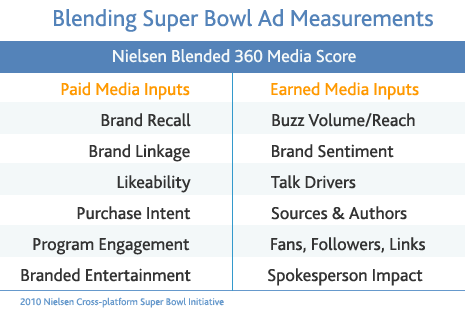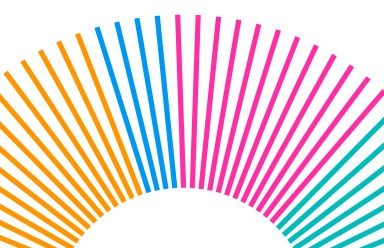Pete Blackshaw, EVP, Digital Strategic Services and Randall Beard, EVP & General Manager, Nielsen IAG
Is the Super Bowl the ultimate marketing ecosystem of paid and earned media? 2010 will be a huge test, as the new reality of consumer expression and cross-platform integration create a powerful new dynamic hovering over the largest single-spot ad spend on record.
What marketers urgently need to understand is not only total ROI on that mega-media buy, but the full return on all the other activities triggered or reinforced by this paid media stimulus. How does paid media drive earned media? And to what degree does earned media halo future paid media efforts? These are critical questions that Marketers need answers to – along with a metric or common yardstick that quantifies the blending of the two.

Getting Real about Real-Time
In a more agile and flexible marketing environment, where there’s actually a chance of making real-time changes based on available data, marketers need to understand the real-time role they can play in making tactical interventions to grow earned media impressions and ultimately, increase odds of success.
Twitter brings a fresh dynamic and promise to Super Bowl media efficiency. The platform reached a reach tipping point in 2009 – so much so that marketers increasingly use it to fan the flames for events, interact with brand mavens or enthusiasts, and, in a growing number of cases, manage or sandbag tension points like customer disappointment or service shortfalls.
Tweets are also increasingly embedding themselves in Facebook feeds, blog entries, and Google search results, magnifying their long-term value. Translated to the Super Bowl, positive playback about Super Bowl ads can have a “latency” effect and provide brands with an almost endless annuity of “earned media.” The same dynamic will be at work with Facebook brand fan pages, which can see massive growth – hundreds of thousands – following a major ad campaign, offline or online.
Quantifying the Big Picture
In the end, Super Bowl spots today need to meet two distinct “torture” tests – one measurable based on traditional TV scoring, and another based on unique dynamics of cross-platform engagement, most notably word-of-mouth and conversation. On a pure TV-impression alone, one can argue that the Super Bowl has become such an unusual magnet for consumer attention and recall – the one day of the year that we “celebrate” advertising – that it is worth every penny. Indeed, curiosity, anticipation, guessing, nostalgia come into play big time before this festival of brand persuasion. Consumers, after all, want to see the ads, almost akin to seeing a movie.
The entertainment halo certainly matters. Over the last three years, Nielsen IAG research found Super Bowl spots achieved a 31% higher break-through and 93% higher likability than the typical ad on television. But it’s not that simple. Timing is also a factor. First and second quarter spots yield more yardage than second half spots, and 4th quarter spots are about comparable to a “normal” TV buy in terms of generating ad recall. The viewer’s ability to associate the correct brand with the ad, and reported likability levels similarly wane over the course of the game. Surprisingly, branded integration effectiveness shows an opposite trend. Recall and brand opinion are lowest pre-game, moderate during the game, and big gainers post game. For Marketers, the mix is clear: focus on ads early and branded integration efforts late. Lastly, the SuperBowl is a touchdown for brands generally: purchase consideration for the average ad the week after increases +13% versus the week prior.
So that’s the foundation of pure “paid” measurements. What about the “earned” side of the equation, which factors in free media, consumer conversation, participation, and the like? Clearly, the Super Bowl in particular shines light across a far more complicated mix of marketing activity and user-engagement. Great copy finds life in other places.
An engaging, even participatory Pepsi game spot, for instance, might trigger a site visit, a Google search, a tweet, retweet, fan-page sign-up, or DVR rewind. It might trigger a desire to share, forward, discuss, critique, rate, or review. It might bleed over into the social media stream of a New York Times or any media reporter (a growing number of whom leverage social media across all platforms.)
The good news is that this digital trail can be quantified with high levels of precision – by volume, reach, tone, source, or even depth of brand advocacy. And much of this can be delivered in real-time, empowering today’s brand manager to make real-time changes or adjustments to the site. Last year, for instance, a large percentage of brands buying spots on the Super Bowl made real-time adjustments to their websites or social media efforts based on pre-game variables.
This year, Frito-Lay’s Doritos brand sits on the extreme of early-adjustments, as the four spots they are running are sourced from user-participation events and contests. In this case, the “earned media” is stimulating the paid side of the equation. Then again, this can work in reverse. When P&G’s Tide brand ran a highly engaging “Talking Stain” spot two years ago, it triggered a user-generated contest that created an impressive annuity of online video that quickly reshaped the brand’s search results for the better. Three years ago, Nationwide insurance estimated that the “earned media” dividend from their Kevin Federline spot totaled over $20 million dollars.
So in the end, it’s just not as simple as “buying” high-reach media. The broader ecosystems truly matter. This year, Nielsen is putting its biggest effort into measuring and quantifying the full return of Super Bowl advertising, combining a comprehensive suite of paid media and earned media metrics into a total “engagement” score. And we don’t intend to stop at the Super Bowl. Over the course of 2010, we’ll be applying our new cross-platform engagement metrics across our work on the Winter Olympics, Academy Awards, and the World Cup.
- Webinar: Learn more about Nielsen’s comprehensive approach to the Super Bowl. Join Pete Blackshaw and Randall Beard for a webinar Maximizing Advertising ROI in a Paid vs. Earned Media Environment on December 8 at 2:00PM EST.



